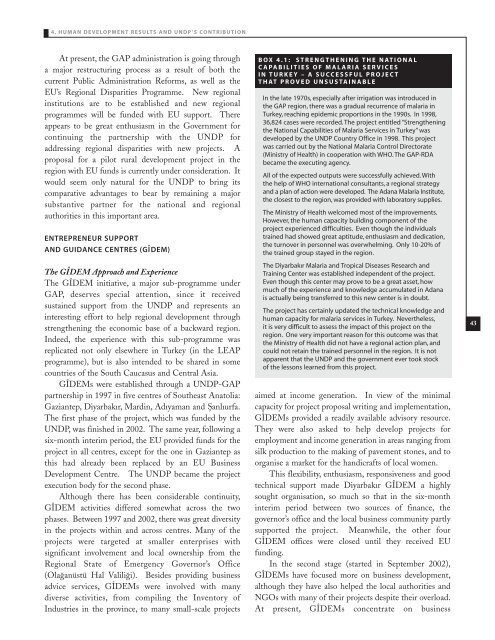Reports - United Nations Development Programme
Reports - United Nations Development Programme
Reports - United Nations Development Programme
You also want an ePaper? Increase the reach of your titles
YUMPU automatically turns print PDFs into web optimized ePapers that Google loves.
4. HUMAN DEVELOPMENT RESULTS AND UNDP’S CONTRIBUTION<br />
At present, the GAP administration is going through<br />
a major restructuring process as a result of both the<br />
current Public Administration Reforms, as well as the<br />
EU’s Regional Disparities <strong>Programme</strong>. New regional<br />
institutions are to be established and new regional<br />
programmes will be funded with EU support. There<br />
appears to be great enthusiasm in the Government for<br />
continuing the partnership with the UNDP for<br />
addressing regional disparities with new projects. A<br />
proposal for a pilot rural development project in the<br />
region with EU funds is currently under consideration. It<br />
would seem only natural for the UNDP to bring its<br />
comparative advantages to bear by remaining a major<br />
substantive partner for the national and regional<br />
authorities in this important area.<br />
ENTREPRENEUR SUPPORT<br />
AND GUIDANCE CENTRES (GI˚DEM)<br />
The GI˚DEM Approach and Experience<br />
The GI˚DEM initiative, a major sub-programme under<br />
GAP, deserves special attention, since it received<br />
sustained support from the UNDP and represents an<br />
interesting effort to help regional development through<br />
strengthening the economic base of a backward region.<br />
Indeed, the experience with this sub-programme was<br />
replicated not only elsewhere in Turkey (in the LEAP<br />
programme), but is also intended to be shared in some<br />
countries of the South Caucasus and Central Asia.<br />
GI˚DEMs were established through a UNDP-GAP<br />
partnership in 1997 in five centres of Southeast Anatolia:<br />
Gaziantep, Diyarbakır, Mardin, Adıyaman and Şanlıurfa.<br />
The first phase of the project, which was funded by the<br />
UNDP, was finished in 2002. The same year, following a<br />
six-month interim period, the EU provided funds for the<br />
project in all centres, except for the one in Gaziantep as<br />
this had already been replaced by an EU Business<br />
<strong>Development</strong> Centre. The UNDP became the project<br />
execution body for the second phase.<br />
Although there has been considerable continuity,<br />
GI˚DEM activities differed somewhat across the two<br />
phases. Between 1997 and 2002, there was great diversity<br />
in the projects within and across centres. Many of the<br />
projects were targeted at smaller enterprises with<br />
significant involvement and local ownership from the<br />
Regional State of Emergency Governor’s Office<br />
(Olağanüstü Hal Valiliği). Besides providing business<br />
advice services, GI˚DEMs were involved with many<br />
diverse activities, from compiling the Inventory of<br />
Industries in the province, to many small-scale projects<br />
BOX 4.1: STRENGTHENING THE NATIONAL<br />
CAPABILITIES OF MALARIA SERVICES<br />
IN TURKEY – A SUCCESSFUL PROJECT<br />
THAT PROVED UNSUSTAINABLE<br />
In the late 1970s, especially after irrigation was introduced in<br />
the GAP region, there was a gradual recurrence of malaria in<br />
Turkey, reaching epidemic proportions in the 1990s. In 1998,<br />
36,824 cases were recorded. The project entitled “Strengthening<br />
the National Capabilities of Malaria Services in Turkey” was<br />
developed by the UNDP Country Office in 1998. This project<br />
was carried out by the National Malaria Control Directorate<br />
(Ministry of Health) in cooperation with WHO. The GAP-RDA<br />
became the executing agency.<br />
All of the expected outputs were successfully achieved. With<br />
the help of WHO international consultants, a regional strategy<br />
and a plan of action were developed. The Adana Malaria Institute,<br />
the closest to the region, was provided with laboratory supplies.<br />
The Ministry of Health welcomed most of the improvements.<br />
However, the human capacity building component of the<br />
project experienced difficulties. Even though the individuals<br />
trained had showed great aptitude, enthusiasm and dedication,<br />
the turnover in personnel was overwhelming. Only 10-20% of<br />
the trained group stayed in the region.<br />
The Diyarbakır Malaria and Tropical Diseases Research and<br />
Training Center was established independent of the project.<br />
Even though this center may prove to be a great asset, how<br />
much of the experience and knowledge accumulated in Adana<br />
is actually being transferred to this new center is in doubt.<br />
The project has certainly updated the technical knowledge and<br />
human capacity for malaria services in Turkey. Nevertheless,<br />
it is very difficult to assess the impact of this project on the<br />
region. One very important reason for this outcome was that<br />
the Ministry of Health did not have a regional action plan, and<br />
could not retain the trained personnel in the region. It is not<br />
apparent that the UNDP and the government ever took stock<br />
of the lessons learned from this project.<br />
aimed at income generation. In view of the minimal<br />
capacity for project proposal writing and implementation,<br />
GI˚DEMs provided a readily available advisory resource.<br />
They were also asked to help develop projects for<br />
employment and income generation in areas ranging from<br />
silk production to the making of pavement stones, and to<br />
organise a market for the handicrafts of local women.<br />
This flexibility, enthusiasm, responsiveness and good<br />
technical support made Diyarbakır GI˚DEM a highly<br />
sought organisation, so much so that in the six-month<br />
interim period between two sources of finance, the<br />
governor’s office and the local business community partly<br />
supported the project. Meanwhile, the other four<br />
GI˚DEM offices were closed until they received EU<br />
funding.<br />
In the second stage (started in September 2002),<br />
GI˚DEMs have focused more on business development,<br />
although they have also helped the local authorities and<br />
NGOs with many of their projects despite their overload.<br />
At present, GI˚DEMs concentrate on business<br />
43

















